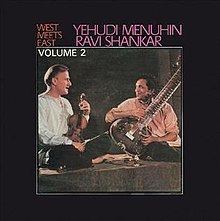Released 15 July 1968 Release date 15 July 1968 | Length 1:03:34 | |
 | ||
Recorded 1967–68Angel Studios, New York City Similar Indian classical music albums, Other albums | ||
West Meets East, Volume 2 is an album by American violinist Yehudi Menuhin and Indian sitar virtuoso Ravi Shankar, released in 1968. It is the second album in a trilogy of collaborations between the two artists, after the Grammy Award-winning West Meets East (1967).
Contents
The release followed Menuhin and Shankar's duet on 10 December 1967 at the United Nations in New York, celebrating the twentieth anniversary of the Universal Declaration of Human Rights. As part of his utopian ideal, international human rights was a cause long supported by Menuhin in his work, while for Indian classical music, this Human Rights Day recital marked the first time that a performance had received a worldwide television broadcast.
Reflecting the celebrity status afforded the sitarist during this period, particularly as a result of his association with George Harrison of the Beatles, Shankar's activities were filmed for a documentary on his life, released as Raga in 1971, and his autobiography My Music, My Life (1968) became a bestseller. Although West Meets East, Volume 2 was another popular success for Menuhin and Shankar, their work together drew further criticism from purists in India, who considered that Shankar was westernising and thus diluting Indian classical music.
Recording and musical content
The follow-up to West Meets East was announced in February 1968, when Billboard magazine reported that Menuhin and Shankar had been recording new material together at Angel Records' New York studios. While their first album continued to top that magazine's Best Selling Classical LP's listings, Shankar had also achieved mainstream success with the recently released Live: Ravi Shankar at the Monterey International Pop Festival, which peaked at number 43 on the Billboard Top LP's chart – the highest US chart placing he would achieve throughout his career. Angel released the new Menuhin–Shankar set on 15 July that year. The album peaked at number 3 on the Classical LP's listings.
West Meets East, Volume 2 contains a version of the piece played at the United Nations, an interpretation of Raga Piloo. According to Shankar's comments in a March 1968 issue of Rolling Stone magazine, they recorded this selection "just a few days ago". As at the recital, Menuhin and Shankar were accompanied by Alla Rakha on tabla and Kamala Chakravarty, Shankar's female companion, on tambura. The second piece is "Raga Ananda Bhairava", performed by Shankar with his regular accompanist and instrument-maker, Nodu Mullick, on tambura, and Rakha again on tabla.
Side two in the original LP format consists of Menuhin and his sister Hephzibah performing Bartók's Sonata No. 1 for Violin and Piano.
Track listing
All selections by Ravi Shankar except where noted.
Side one
- "Raga Piloo" – 14:44
- "Raga Ananda Bhairava" – 15:37
Side two
- "Sonata for Violin & Piano No. 1" (Béla Bartók) – 33:13
